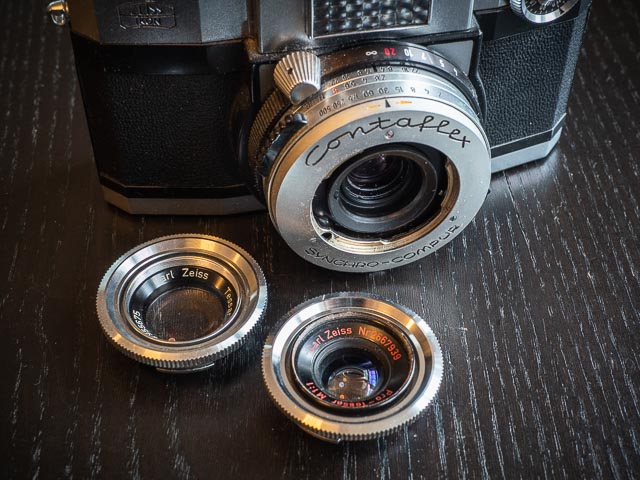Zeiss Ikon Contaflex Super

In the 1950s and 60s 35mm SLRs with in-lens leaf-shutters were a very popular class of cameras amongst advanced amateur photographers. The offered the considerable advantage of much lower manufacturing costs compared to the still fairly new focal plane shutter technology which was largely confined to very expensive professional SLRs. The disadvantage was that it was very difficult to design interchangeable lenses with in-lens leaf shutters, so most cameras in this class had wither fixed lenses, or had partially fixed lenses where only the first element was interchangeable. Lenses of this type were generally limited to a focal length range of approximately 35-100mm.
This class of camera was particularly popular amongst German camera companies, which still dominated the photography industry at this time. The Zeiss Ikon was the first company to produce cameras in this class with the Zeiss Ikon Contaflex launched in 1953. The other big players in this class were Voigtlander with their Bessamatic line of cameras, and the West German arm of Kodak with their Retina line of SLRs. The Zeiss Ikon Contaflex range ran along side their Contarex line of extremely expensive professional focal plane shutter SLRs.
The model you see here is the Contaflex Super was launched in 1959. At launch this was at the top of the Contaflex line, and had partially interchangeable lenses from 35mm to 115mm and a coupled selenium cell light meter with swinging needle indicators both in the viewfinder and on the top plate. (This kind of system was often referred to at the time as automatic exposure, though we certainly would call it such today!) This made the camera very convenient to operate by the standards of the time, although, like most leaf-shutter SLRs, the mirror was not of the instant return type, so the viewfinder was blacked out until the film was wound on. There was also an 8x30 monocular with an adapter allowing it to be attached to the front of the 50mm f/2.8 standard lens to provide the equivilent of a 400mm f/14 lens
Another lens option was a very early macro lens (illustrated below) which allowed a life-size 1:1 reproduction ratio. But the problem was that this although this lens allowed you to focus close enough for the 1:1 reproduction ratio it's very limited focusing range didn't let you focus at very much less tham a 1:1 reproduction ratio either! As modern photographers we should be very grateful for the convenience of macro lenses that focus all the way from 1:1 to infinity!



| Type of camera: | Single-lens miniature reflex camera. |
|---|---|
| Format: | 24x36 mm, Cartidges or cassettes for 20 or 36 exposures can be used. |
| Film advance: | Rapid lever wind, opens diaphragm, tensions shutter and advances the film. Double exposures and blanks excluded. |
| Shutter: | Syncro-Compur, dustproff when changing lenses, shutter speeds "b", 1-1/500 sec. "X" and "M" synchronised flash contact. Built-in delayed action device running for 8 seconds. Spring loaded pre-selector diaphragm. |
| Lens: | ZEISS TESSAR f/2.8, 50mm as standard lens. Front element interchangable for: PRO-TESSAR f/4, 115mm (tele lens) PRO-TESSAR f/4, 85mm (tele lens) PRO-TESSAR f/4, 35mm (wide-angle lens) (later replaced by a 35mm f/3.2 variant) PRO-TESSAR M 1:1ZEISS Monocular attachement 8 x 30 (equivilent to f/14, 400mm tele-lens) STERITAR stereo-attachment for distances from infinity to 8 feet Close-up STERITAR for distances from 8 feet to 26 inches. |
| Automatic exposure control: | Coupled to the shutter. Compensated for temperature variations. Indicatio according to zero-method, visible on the camera body or in the viewfinder. |
| Rangefinder: | Two different indicators: split image rangefinder and fine screen ring. |
| Viewfinder: | Reflected image through the taking lens completely free from paralax no matter which lens is used. Upright and laterally corect image of natural size by means of a mirror and pentaprism. Fresnel lens makes the image bright and sharp right up to the edges. |
| General features: | Frame counter - film type indicator - filter corrector - accessory shoe - semi-automatic film unlocking for rewinding - rewide knob with countersunk crank. |

